6.30: Biomas Terrestres
- Page ID
- 107965
\( \newcommand{\vecs}[1]{\overset { \scriptstyle \rightharpoonup} {\mathbf{#1}} } \)
\( \newcommand{\vecd}[1]{\overset{-\!-\!\rightharpoonup}{\vphantom{a}\smash {#1}}} \)
\( \newcommand{\dsum}{\displaystyle\sum\limits} \)
\( \newcommand{\dint}{\displaystyle\int\limits} \)
\( \newcommand{\dlim}{\displaystyle\lim\limits} \)
\( \newcommand{\id}{\mathrm{id}}\) \( \newcommand{\Span}{\mathrm{span}}\)
( \newcommand{\kernel}{\mathrm{null}\,}\) \( \newcommand{\range}{\mathrm{range}\,}\)
\( \newcommand{\RealPart}{\mathrm{Re}}\) \( \newcommand{\ImaginaryPart}{\mathrm{Im}}\)
\( \newcommand{\Argument}{\mathrm{Arg}}\) \( \newcommand{\norm}[1]{\| #1 \|}\)
\( \newcommand{\inner}[2]{\langle #1, #2 \rangle}\)
\( \newcommand{\Span}{\mathrm{span}}\)
\( \newcommand{\id}{\mathrm{id}}\)
\( \newcommand{\Span}{\mathrm{span}}\)
\( \newcommand{\kernel}{\mathrm{null}\,}\)
\( \newcommand{\range}{\mathrm{range}\,}\)
\( \newcommand{\RealPart}{\mathrm{Re}}\)
\( \newcommand{\ImaginaryPart}{\mathrm{Im}}\)
\( \newcommand{\Argument}{\mathrm{Arg}}\)
\( \newcommand{\norm}[1]{\| #1 \|}\)
\( \newcommand{\inner}[2]{\langle #1, #2 \rangle}\)
\( \newcommand{\Span}{\mathrm{span}}\) \( \newcommand{\AA}{\unicode[.8,0]{x212B}}\)
\( \newcommand{\vectorA}[1]{\vec{#1}} % arrow\)
\( \newcommand{\vectorAt}[1]{\vec{\text{#1}}} % arrow\)
\( \newcommand{\vectorB}[1]{\overset { \scriptstyle \rightharpoonup} {\mathbf{#1}} } \)
\( \newcommand{\vectorC}[1]{\textbf{#1}} \)
\( \newcommand{\vectorD}[1]{\overrightarrow{#1}} \)
\( \newcommand{\vectorDt}[1]{\overrightarrow{\text{#1}}} \)
\( \newcommand{\vectE}[1]{\overset{-\!-\!\rightharpoonup}{\vphantom{a}\smash{\mathbf {#1}}}} \)
\( \newcommand{\vecs}[1]{\overset { \scriptstyle \rightharpoonup} {\mathbf{#1}} } \)
\( \newcommand{\vecd}[1]{\overset{-\!-\!\rightharpoonup}{\vphantom{a}\smash {#1}}} \)
\(\newcommand{\avec}{\mathbf a}\) \(\newcommand{\bvec}{\mathbf b}\) \(\newcommand{\cvec}{\mathbf c}\) \(\newcommand{\dvec}{\mathbf d}\) \(\newcommand{\dtil}{\widetilde{\mathbf d}}\) \(\newcommand{\evec}{\mathbf e}\) \(\newcommand{\fvec}{\mathbf f}\) \(\newcommand{\nvec}{\mathbf n}\) \(\newcommand{\pvec}{\mathbf p}\) \(\newcommand{\qvec}{\mathbf q}\) \(\newcommand{\svec}{\mathbf s}\) \(\newcommand{\tvec}{\mathbf t}\) \(\newcommand{\uvec}{\mathbf u}\) \(\newcommand{\vvec}{\mathbf v}\) \(\newcommand{\wvec}{\mathbf w}\) \(\newcommand{\xvec}{\mathbf x}\) \(\newcommand{\yvec}{\mathbf y}\) \(\newcommand{\zvec}{\mathbf z}\) \(\newcommand{\rvec}{\mathbf r}\) \(\newcommand{\mvec}{\mathbf m}\) \(\newcommand{\zerovec}{\mathbf 0}\) \(\newcommand{\onevec}{\mathbf 1}\) \(\newcommand{\real}{\mathbb R}\) \(\newcommand{\twovec}[2]{\left[\begin{array}{r}#1 \\ #2 \end{array}\right]}\) \(\newcommand{\ctwovec}[2]{\left[\begin{array}{c}#1 \\ #2 \end{array}\right]}\) \(\newcommand{\threevec}[3]{\left[\begin{array}{r}#1 \\ #2 \\ #3 \end{array}\right]}\) \(\newcommand{\cthreevec}[3]{\left[\begin{array}{c}#1 \\ #2 \\ #3 \end{array}\right]}\) \(\newcommand{\fourvec}[4]{\left[\begin{array}{r}#1 \\ #2 \\ #3 \\ #4 \end{array}\right]}\) \(\newcommand{\cfourvec}[4]{\left[\begin{array}{c}#1 \\ #2 \\ #3 \\ #4 \end{array}\right]}\) \(\newcommand{\fivevec}[5]{\left[\begin{array}{r}#1 \\ #2 \\ #3 \\ #4 \\ #5 \\ \end{array}\right]}\) \(\newcommand{\cfivevec}[5]{\left[\begin{array}{c}#1 \\ #2 \\ #3 \\ #4 \\ #5 \\ \end{array}\right]}\) \(\newcommand{\mattwo}[4]{\left[\begin{array}{rr}#1 \amp #2 \\ #3 \amp #4 \\ \end{array}\right]}\) \(\newcommand{\laspan}[1]{\text{Span}\{#1\}}\) \(\newcommand{\bcal}{\cal B}\) \(\newcommand{\ccal}{\cal C}\) \(\newcommand{\scal}{\cal S}\) \(\newcommand{\wcal}{\cal W}\) \(\newcommand{\ecal}{\cal E}\) \(\newcommand{\coords}[2]{\left\{#1\right\}_{#2}}\) \(\newcommand{\gray}[1]{\color{gray}{#1}}\) \(\newcommand{\lgray}[1]{\color{lightgray}{#1}}\) \(\newcommand{\rank}{\operatorname{rank}}\) \(\newcommand{\row}{\text{Row}}\) \(\newcommand{\col}{\text{Col}}\) \(\renewcommand{\row}{\text{Row}}\) \(\newcommand{\nul}{\text{Nul}}\) \(\newcommand{\var}{\text{Var}}\) \(\newcommand{\corr}{\text{corr}}\) \(\newcommand{\len}[1]{\left|#1\right|}\) \(\newcommand{\bbar}{\overline{\bvec}}\) \(\newcommand{\bhat}{\widehat{\bvec}}\) \(\newcommand{\bperp}{\bvec^\perp}\) \(\newcommand{\xhat}{\widehat{\xvec}}\) \(\newcommand{\vhat}{\widehat{\vvec}}\) \(\newcommand{\uhat}{\widehat{\uvec}}\) \(\newcommand{\what}{\widehat{\wvec}}\) \(\newcommand{\Sighat}{\widehat{\Sigma}}\) \(\newcommand{\lt}{<}\) \(\newcommand{\gt}{>}\) \(\newcommand{\amp}{&}\) \(\definecolor{fillinmathshade}{gray}{0.9}\)
Bosque vs desierto. ¿Qué explica estas diferencias?
Si miras estas dos imágenes, verás muy pocas similitudes. La imagen de la izquierda muestra un desierto en África. La imagen de la derecha muestra una selva tropical en Australia. El desierto no tiene plantas visibles, mientras que la selva tropical está densamente repleta de árboles. ¿Tienen diferentes climas? ¿Uno recibe más lluvia que el otro?
Levantamiento de Biomas Terrestres
Los biomas terrestres se clasifican por el clima y su biodiversidad, especialmente los tipos de productores primarios. El mapa del mundo en la Figura siguiente muestra dónde se encuentran 13 biomas terrestres principales.
 Distribución Mundial de Biomas Terrestres. Este mapa muestra las ubicaciones de los principales biomas terrestres de la Tierra.
Distribución Mundial de Biomas Terrestres. Este mapa muestra las ubicaciones de los principales biomas terrestres de la Tierra. Las siguientes cifras resumen las características básicas de los principales biomas terrestres. Al leer sobre cada bioma, piense en cómo su biodiversidad y los tipos de plantas y animales se relacionan con su clima. Por ejemplo, ¿por qué crees que no hay anfibios ni reptiles en los biomas de la tundra? (Pista: Los anfibios y reptiles no pueden mantener una temperatura corporal constante. En cambio, tienen aproximadamente la misma temperatura que su entorno.)
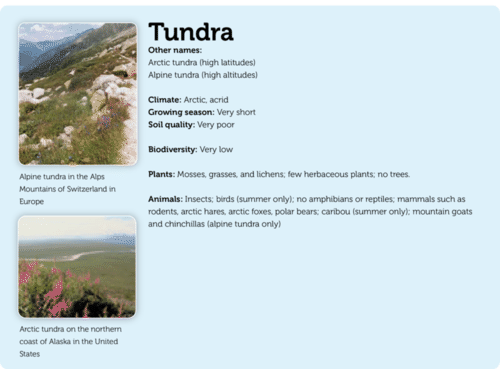

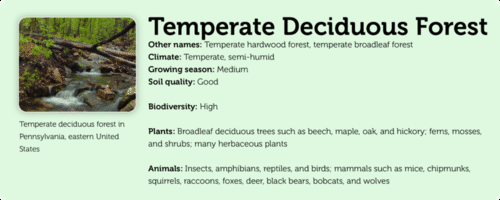
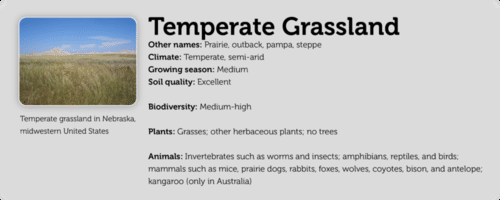
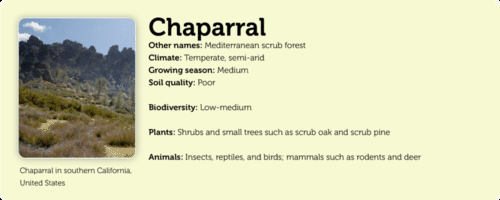
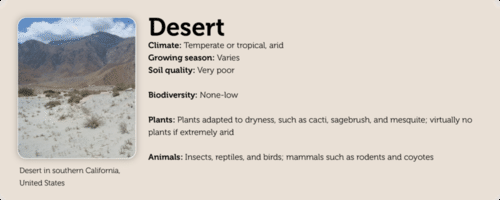

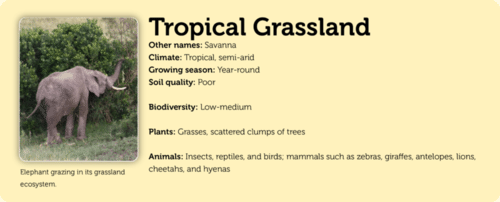
Viernes de la Ciencia: Superbloom: Cómo el Valle de la Muerte cobra vida
Un enorme banco de semillas de flores silvestres del desierto se encuentra debajo del Valle de la Muerte. Este video de Science Friday muestra que cuando las fuertes lluvias invernales se sumergen profundamente en el suelo, estas maravillas ocultas cobran vida, en un evento llamado “superbloom”.
Resumen
- Los biomas terrestres incluyen tundras, bosques templados y pastizales, desiertos chaparrales, templados y tropicales, y bosques tropicales y pastizales.
Revisar
- Identificar dos tipos de tundra y dónde se encuentran.
- ¿Qué bioma terrestre tiene la mayor biodiversidad? el más bajo?
- ¿En qué bioma es más probable que encuentres pastos, cebras y leones?
- Si tuvieras que diseñar un animal del desierto bien adaptado, ¿qué adaptaciones le darías para ayudarle a sobrevivir en su bioma del desierto?
| Imagen | Referencia | Atribuciones |
 |
[Figura 1] | Crédito: Desierto: Flickr:Wonker; Selva tropical: Usuario:Tim35/Wikipedia Fuente: Desierto: http://www.flickr.com/photos/wonker/4300437105/; Selva tropical: commons.wikimedia.org/wiki/Archivo:Rainforrest_entre_kuranda_and_cairns; _North_East_Queensland.jpg Licencia: Desierto: CC BY 2.0; Selva: Dominio público |
 |
[Figura 2] | Crédito: Fundación CK-12 Fuente: Fundación CK-12 Licencia: CC BY-NC 3.0 |
 |
[Figura 3] | Crédito: Fundación CK-12, Fawcett5/Wikimedia Commons, Servicio de Pesca y Vida Silvestre de Estados Unidos Fuente: Commons.wikimedia.org/wiki/Archivo:Alpine_Flora.png; Commons.wikimedia.org/wiki/Archivo:Tundra_Coastal_Vegetation_Alaska.jpg Licencia: CC BY-NC |
 |
[Figura 4] | Crédito: Administración Nacional Oceánica y Atmosférica Fuente: Commons.wikimedia.org/wiki/Archivo:Picea_Mariana_Taiga.jpg Licencia: CC BY-NC |
 |
[Figura 5] | Crédito: Fundación CK-12, Nicholas A. Tonelli Fuente: www.flickr.com/photos/nicholas_t/6958582046/ Licencia: CC BY-NC 2.0 |
 |
[Figura 6] | Crédito: Brian Kell, Fundación CK-12 Fuente: Commons.wikimedia.org/wiki/Archivo:Oglala_Nacional_Grassland.jpg Licencia: CC BY-NC 2.0 |
 |
[Figura 7] | Crédito: Fundación CK-12, Miguel Vieira Fuente: www.flickr.com/photos/miguelvieira/3384303160/ Licencia: CC BY-NC 2.0 |
 |
[Figura 8] | Crédito: Ju Dadalto, Fundación CK-12 Fuente: http://www.flickr.com/photos/black-bird/2584138571/ Licencia: CC BY-NC 2.0 |
 |
[Figura 9] | Crédito: lana.japan; Flickr, Ethan Roos Fuente: http://www.flickr.com/photos/13007595@N05/2697183159/ Licencia: CC BY-NC 2.0 |
 |
[Figura 10] | Crédito: Shankar S., Fundación CK-12 Fuente: https://www.flickr.com/photos/shankaronline/7513383356/ Licencia: CC BY-NC 2.0 |

